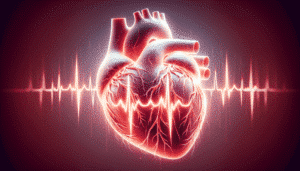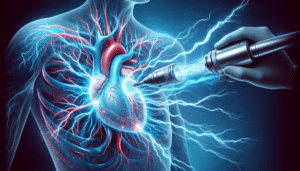AFib Treatment Options: A Comprehensive Guide.
Find the ideal AFib treatment option for you. Atrial fibrillation (AFib) is a common heart rhythm disorder affecting millions of people worldwide. It is crucial for individuals experiencing AFib to understand the condition and seek appropriate atrial fibrillation treatment before it leads to severe health consequences. This blog post aims to provide the necessary knowledge and guidance to help you navigate the complex world of atrial fibrillation, its treatment options, and how to manage it effectively.
Short Summary
-
Atrial Fibrillation Treatment requires understanding the progression of the condition and setting goals to reduce stroke risk, control heart rate, and promote normal rhythm.
-
Medications, procedures & surgery are used for treatment while lifestyle changes and home remedies can help manage it.
Understanding Atrial Fibrillation
Atrial fibrillation (AFib) is the most prevalent form of heart arrhythmia, characterized by episodes of accelerated heart rate, or sometimes described as an irregular heartbeat. AFib also may go unnoticed, as some individuals may not experience any symptoms, making it possible for a physician to detect it during a routine physical exam for other purposes. Early atrial fibrillation diagnosis is crucial to prevent stroke and other serious complications associated with atrial fibrillation.
There are various underlying disorders that could increase the risk of atrial fibrillation, such as:
-
Overweight or obesity
-
Sleep apnea
-
High blood pressure
-
An overactive thyroid gland
-
Diabetes
A comprehensive evaluation is the first step in AFib treatment, which may include blood thinning medications to reduce the risk of stroke.
Uncontrolled atrial fibrillation may cause other complications, such as strokes and heart failure, which will require aggressive treatment in some cases. Therefore, it is essential to obtain treatment to effectively manage atrial fibrillation and minimize the risk of serious health consequences.
The primary goal of AFib treatment is to improve symptoms, maintain normal sinus rhythm, and reduce the risk of stroke by preventing blood clots.
Understanding The Progression of AFib.
When someone is diagnosed with AFib, their disease state typically progresses through stages. It is essential to understand these stages, as the success rate of AFib treatment is much better during earlier stages of AFib. The typical stages of AFib include:
1. Paroxysmal atrial fibrillation — This early stage of AFib is characterized by symptoms that come and go. Typically, patients with paroxysmal atrial fibrillation are in a normal rhythm most of the time.
2. Persistent atrial fibrillation — As a person experiences more and more episodes of AFib, the episodes and the duration of atrial fibrillation last for longer amounts of time. Persistent atrial fibrillation is defined as atrial fibrillation that has lasted for longer than seven days.
Depending on the severity of a person’s symptoms and what stage of the disease they are in, various treatment options can be used to reduce the risk of developing serious complications.

AFib Treatment Goals
A personalized treatment plan is essential to treat atrial fibrillation, as it varies among individuals, and the most suitable treatment depends on factors such as the underlying cause, age, and overall health of the patient. Treatment options include medications, non-surgical procedures, and surgical interventions, each aiming to reduce the risk of stroke, manage heart rate, and restore a normal rhythm.
Medical Therapy for AFib
Typically, when someone is first diagnosed with AFib, they are started on medications to help manage their symptoms. There are a couple of different categories of medications commonly used to treat various symptoms and complications.
Heart Rate Altering Medications
These medications are commonly prescribed to patients with AFib because they help control the rate that the heart is beating. In patients with AFib, the irregular and very fast heart rate needs to be slowed down to reduce the risk of heart damage, and to reduce symptoms. Two classes of medications (beta-blockers and calcium channel blockers) are commonly used help to slow down the rate of the heart muscle. Examples of these medications include:
Beta-Blockers:
● Metoprolol
● Atenolol
● Carvedilol
● Bisoprolol
● Labetalol
Calcium Channel Blockers:
● Diltiazem
● Verapamil
In general, beta-blockers and calcium channel blockers are the most commonly used initial treatments for atrial fibrillation. This is because these medications are usually well tolerated with low risk for serious side effects.
Your Complete Guide To AFib: The Essential Manual For Every Patient With Atrial Fibrillation
$15.95 $14.35 (as of June 14, 2025 15:06 GMT -06:00 – More infoProduct prices and availability are accurate as of the date/time indicated and are subject to change. Any price and availability information displayed on [relevant Amazon Site(s), as applicable] at the time of purchase will apply to the purchase of this product.)
Heart Rhythm Altering Medications to Restore Normal Heart Rhythm (Anti-Arrhythmic Medications)
In cases of significant AFib symptoms, or symptoms refractory to commonly used beta-blockers, you may require additional medications designed to adjust and correct the electrical activity of the heart. These medications usually affect either the sodium or potassium channels of the heart to treat AFib. There are more restrictions and increased potential side effects with these medications, so these are not typically used as a first-line treatment option. In addition, these stronger anti-arrhythmic medications are more commonly prescribed by an electrophysiologist. Examples of heart rhythm altering medications include:
Sodium channel blockers:
● Flecainide
● Propafenone
● Quinidine
Potassium channel blockers:
● Amiodarone
● Sotalol
● Dofetilide
● Multaq
AFib Treatment: Blood Thinners to Reduce Blood Clots and Stroke
One of the significant complications of atrial fibrillation is stroke. Stroke in AFib is caused by blood clots forming in the atrium during atrial fibrillation and becoming dislodged, and later traveling into major blood vessels, including the brain. Preventing strokes is a major component of managing atrial fibrillation. Blood-thinning medications are used to prevent blood clots from forming in the heart to reduce the risk of a stroke. Common blood thinner medications for atrial fibrillation patients include:
● Warfarin
● Xarelto (Rivaroxaban)
● Enoxaparin (an injection usually only used for short term treatment)
● Pradaxa
● Savaysa
● Aspirin (relatively weak blood thinner, and no longer recommended for stroke risk reduction in AFib as per the most recent Heart Rhythm Society Guidelines)
Non-Surgical or Minimally Invasive Procedures
For some, medications are enough to stabilize their symptoms. But, for those who have reactions to medications, profound AFib symptoms, or do not want to take medications every day, there are several procedure options available. Some of the most common procedures available today include:
Electrical Cardioversion
A cardioversion is a very simple fix with relatively low risks when compared to other procedures for AFib. The procedure involves using electrical energy to shock the heart back into a normal rhythm. If you want to read more about cardioversions, check out my article about cardioversions here.
Catheter Ablation for AFib
Catheter ablation for atrial fibrillation (AFib) is a minimally invasive procedure designed to treat the abnormal heart rhythm by targeting and disrupting the sources of erratic electrical signals in the heart. During the procedure, a thin, flexible catheter is inserted through a blood vessel, typically in the groin, and guided to the heart. Using advanced mapping and imaging technologies, the areas responsible for triggering or maintaining AFib are identified. High-frequency energy, such as radiofrequency or cryotherapy, is then delivered through the catheter to create scar tissue, interrupting the abnormal electrical pathways. This scar tissue helps restore a more regular heart rhythm and reduces the frequency and severity of AFib episodes, providing relief to patients and potentially decreasing their reliance on medication. Catheter ablation has proven to be an effective treatment option for many patients with AFib, improving their quality of life and reducing the risk of complications associated with this condition.
If you would like to read more about the procedure details of a catheter ablation, check out my article on what really happens during a catheter ablation.
Surgical Options for AFib Treatment
For those who do not respond well to medications or non-surgical or minimally invasive procedures, surgical options such as surgical ablation, the maze, or mini maze procedure may be considered.
The most common type of surgical ablation is the mini-maze procedure. During this procedure, small incisions are made in the chest, and a specialized catheter is inserted to access the heart’s surface. The surgeon then creates a series of controlled lesions or scar lines using various energy sources, such as radiofrequency or cryotherapy, to disrupt the abnormal electrical pathways that cause AF. These scar lines redirect the electrical signals, restoring a more organized rhythm in the heart. The less invasive nature of the mini-maze procedure reduces postoperative complications and shortens recovery times compared to traditional open-heart surgeries. In general, surgical ablation procedures such as the mini-maze procedure are a more invasive form of an ablation when compared to a catheter ablation procedure. They typically have higher surgical risks and a longer recovery time, but they may have a higher success rate for some patients. To learn more about the mini-maze procedure, check out this article about surgical treatment options.
AFib Treatment: Lifestyle Changes and Home Remedies
In addition to medical treatments and procedures, lifestyle modifications can be highly beneficial for managing atrial fibrillation and improving overall heart health. Some lifestyle modifications to consider include:
-
Regular exercise
-
Maintaining a healthy weight or losing weight if obese
-
Alleviating stress
-
Abstaining from alcohol and smoking
These lifestyle changes can help reduce AFib burden, improve symptoms, and enhance quality of life.
Home remedies that may be beneficial for managing atrial fibrillation include yoga, meditation, and relaxation techniques. Furthermore, abstaining from caffeine and alcohol consumption, and obtaining adequate sleep may help to reduce symptoms of AFib.
By making these lifestyle changes and incorporating home remedies into your daily routine, you can not only manage atrial fibrillation more effectively, but also prevent or treat other conditions such as High blood pressure and heart disease.
Is It Possible to Reverse Atrial Fibrillation Naturally?
It is possible to improve your atrial fibrillation symptoms by making changes to your lifestyle. Incorporating things such as dietary changes, increased exercise, and having a proper sleep schedule can positively impact your AFib. If you are interested in natural treatment options for atrial fibrillation and are highly motivated in improving your symptoms naturally, to reduce your need for medications or even procedures, then take a look at my one-of-a-kind, online educational program, Take Control Over AFib.
Lifestyle modifications and reducing inflammation are essential components of the long-term management of atrial fibrillation. Addressing the source cause of atrial fibrillation can lead to a significant benefit for most AFib patients. Targeted lifestyle modifications can reduce your symptoms, reduce your reliance on medications or procedures, and even improve the long-term success rate of a catheter ablation procedure for AFib. However, most patients are not given instructions or tips on how to accomplish these essential lifestyle modifications in an AFib targeted style.
This is exactly why I created the Take Control Over AFib Program, to give people a step-by-step plan to improve and potentially reverse atrial fibrillation naturally, as quickly as possible.
Thinking about lifestyle modifications is easy, but putting in place a system to keep you committed to achieve real results takes time and dedication, and with my step-by-step plan, we can achieve powerful and long-lasting results together.
Summary
In conclusion, understanding atrial fibrillation and its various treatment options is crucial for managing the condition effectively and minimizing the risk of serious health consequences. By seeking appropriate medical care, making lifestyle changes, and staying informed about ongoing research and developments in the field, individuals with atrial fibrillation can take control of their heart health and lead fulfilling lives.
Frequently Asked Questions
What is the Most Common Treatment for Atrial Fibrillation?
The most common treatments for atrial fibrillation (AF) include medications like anticoagulants and antiarrhythmic drugs to manage the irregular heartbeat and reduce the risk of blood clots. Cardioversion, which uses electric shocks or medications, is often employed to restore a normal heart rhythm. Minimally invasive procedures like catheter ablation involve creating scar tissue to block faulty electrical pathways, while surgical ablation can achieve similar results through open-heart surgery. Lifestyle changes and, in some cases, pacemaker implantation may also be recommended to effectively manage AF based on individual patient needs and medical considerations. Consulting healthcare professionals is crucial to determining the best treatment plan for each patient.
What is the First Choice Treatment for Atrial Fibrillation?
The first-choice treatment for atrial fibrillation (AF) depends on several factors, including the type and severity of the AF, the patient’s overall health, and their medical history. In many cases, doctors initially prescribe medications such as anticoagulants to prevent blood clots and reduce the risk of stroke, along with antiarrhythmic drugs to control the heart’s rhythm and rate. These medications aim to manage AF and improve the patient’s quality of life. However, the specific treatment approach may vary for each individual, and decisions should be made in consultation with healthcare professionals who can tailor the treatment plan to suit the patient’s unique needs and circumstances.
How Do You Stop an AFib Episode?
If you are experiencing severe symptoms of atrial fibrillation (AFib), it is important to seek medical attention immediately, especially if you are having chest pain, shortness of breath, or fainting. While some people may try to stop AFib at home, it is important to keep in mind that these strategies are not guaranteed to work and may not be safe for everyone.
However, if you have been advised by your healthcare professional and feel confident doing so, some strategies that may help to stop AFib temporarily at home include:
-
Valsalva Maneuver: This involves bearing down as if trying to have a bowel movement, which can help reset the heart’s rhythm.
-
Carotid Sinus Massage: This involves applying pressure to the side of the neck near the carotid artery, which may help reset the heart’s rhythm.
Controlled Deep Breathing: Taking slow, deep breaths can help slow down the heart rate and reduce symptoms of AFib.
Read More About How To Stop AFib at Home Here
It is important to keep in mind that these strategies are not a substitute for medical care, and that seeking prompt medical attention is the best course of action if you are experiencing symptoms of AFib. Additionally, if these strategies are not effective in stopping AFib, or if AFib is accompanied by chest pain, shortness of breath, or fainting, it is important to seek medical attention immediately.
Can You Make AFib Go Away?
Atrial fibrillation can be managed and controlled, but it is usually not 100% curable. In some cases, the underlying cause of the condition can be treated, which may result in the resolution of symptoms. However, in most cases, atrial fibrillation is a chronic condition that requires ongoing management and treatment to reduce the risk of complications and improve symptoms. Lifestyle changes, such as maintaining a healthy weight, managing stress, and avoiding triggers like caffeine and alcohol, may help reduce the frequency and severity of symptoms. However, it is important to work with a healthcare provider to develop an individualized treatment plan that is safe and effective for your specific needs and circumstances.
Does AFib Damage The Heart?
AFib can damage the heart in multiple ways. The longer a person is in atrial fibrillation, the more damage that happens to the muscles of the atria. The more AFib someone has, the more scar tissue, called fibrosis, builds up in the atria. The more fibrosis, the harder it will be to reverse or improve AFib. Additionally, a rapid heart rate for several weeks or months can severely weaken the overall strength of the ventricles and lead to congestive heart failure.
The Best Atrial Fibrillation Book
Your Complete Guide To AFib: The Essential Manual For Every Patient With Atrial Fibrillation

Shop AFib Products on Amazon
KardiaMobile 6-Lead Personal EKG Monitor – Six Views of The Heart – Detects AFib and Irregular Arrhythmias – Instant Results in 30 Seconds – Works with Most Smartphones - FSA/HSA Eligible
13% Off
KardiaMobile 1-Lead Personal EKG Monitor – Record EKGs at Home – Detects AFib and Irregular Arrhythmias – Instant Results in 30 Seconds – Easy to Use – Works with Most Smartphones - FSA/HSA Eligible
$79.00 (as of June 14, 2025 15:10 GMT -06:00 - More infoProduct prices and availability are accurate as of the date/time indicated and are subject to change. Any price and availability information displayed on [relevant Amazon Site(s), as applicable] at the time of purchase will apply to the purchase of this product.)
Apple Watch Series 9 [GPS 41mm] Smartwatch with Storm Blue Aluminum Case with Silver Sport Band M/L. Fitness Tracker, Blood Oxygen & ECG Apps, Always-On Retina Display
(as of June 14, 2025 08:29 GMT -06:00 - More infoProduct prices and availability are accurate as of the date/time indicated and are subject to change. Any price and availability information displayed on [relevant Amazon Site(s), as applicable] at the time of purchase will apply to the purchase of this product.)
Fitbit Sense 2 Advanced Health and Fitness Smartwatch with Tools to Manage Stress and Sleep, ECG App, SpO2, 24/7 Heart Rate and GPS, Shadow Grey/Graphite, One Size (S & L Bands Included)
20% Off
OMRON 2-in-1 Upper Arm Blood Pressure Monitor & 1-Lead EKG Monitor - Clinically Validated Blood Pressure Arm Cuff & Machine - Use OMRON Connect App
21% Off
Samsung Galaxy Watch 6 44mm Bluetooth Smartwatch, Fitness Tracker, Personalized HR Zones, Advanced Sleep Coaching, Heart Monitor, BIA Sensor, Health Wellness Insights, Big Screen, US Version, Graphite
9% Off
Natural Rhythm Triple Calm Magnesium 150 mg - 120 Capsules – Magnesium Complex Compound Supplement with Magnesium Glycinate, Malate, and Taurate. Calming Blend for Promoting Rest and Relaxation.
$20.77 ($0.17 / Count) (as of June 14, 2025 17:38 GMT -06:00 - More infoProduct prices and availability are accurate as of the date/time indicated and are subject to change. Any price and availability information displayed on [relevant Amazon Site(s), as applicable] at the time of purchase will apply to the purchase of this product.)
Pure Encapsulations Magnesium (Glycinate) - Supplement to Support Stress Relief, Sleep, Heart Health, Nerves, Muscles, and Metabolism* - with Magnesium Glycinate - 180 Capsules
$44.60 ($0.25 / Count) (as of June 14, 2025 08:29 GMT -06:00 - More infoProduct prices and availability are accurate as of the date/time indicated and are subject to change. Any price and availability information displayed on [relevant Amazon Site(s), as applicable] at the time of purchase will apply to the purchase of this product.)
















![Apple Watch Series 9 [GPS 41mm] Smartwatch with Storm Blue Aluminum Case with Silver Sport Band M/L. Fitness Tracker, Blood Oxygen & ECG Apps, Always-On Retina Display #1](https://m.media-amazon.com/images/I/311xwtp4mFL._SL100_.jpg)
![Apple Watch Series 9 [GPS 41mm] Smartwatch with Storm Blue Aluminum Case with Silver Sport Band M/L. Fitness Tracker, Blood Oxygen & ECG Apps, Always-On Retina Display #2](https://m.media-amazon.com/images/I/41j+8AaUGsL._SL100_.jpg)
![Apple Watch Series 9 [GPS 41mm] Smartwatch with Storm Blue Aluminum Case with Silver Sport Band M/L. Fitness Tracker, Blood Oxygen & ECG Apps, Always-On Retina Display #3](https://m.media-amazon.com/images/I/41jIyxZitnL._SL100_.jpg)
![Apple Watch Series 9 [GPS 41mm] Smartwatch with Storm Blue Aluminum Case with Silver Sport Band M/L. Fitness Tracker, Blood Oxygen & ECG Apps, Always-On Retina Display #4](https://m.media-amazon.com/images/I/41IpNJERjCL._SL100_.jpg)
![Apple Watch Series 9 [GPS 41mm] Smartwatch with Storm Blue Aluminum Case with Silver Sport Band M/L. Fitness Tracker, Blood Oxygen & ECG Apps, Always-On Retina Display #5](https://m.media-amazon.com/images/I/31o17yhfYpL._SL100_.jpg)





































